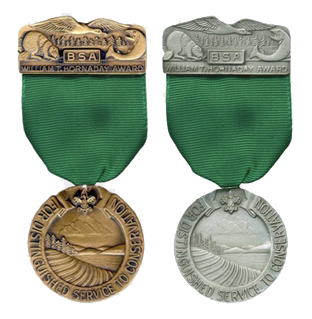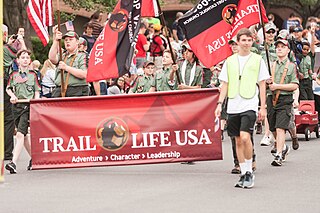
The Boy Scouts of America is one of the largest scouting organizations and one of the largest youth organizations in the United States, with about 1.2 million youth participants. The BSA was founded in 1910, and since then, about 110 million Americans have participated in BSA programs. BSA is part of the international Scout Movement and became a founding member organization of the World Organization of the Scout Movement in 1922.

The Order of the Arrow (OA) is the honor society of the Boy Scouts of America (BSA), composed of Scouts and Scouters who best exemplify the Scout Oath and Law in their daily lives as elected by their peers. The society was created by E. Urner Goodman, with the assistance of Carroll A. Edson, in 1915 as a means of reinforcing the Scout Oath and the Scout Law. It uses imagery commonly associated with American Indian cultures for its self-invented ceremonies. These ceremonies are usually for recognition of leadership qualities, camping skills, and other scouting ideals as exemplified by their elected peers.

Camp Fire, formerly Camp Fire USA and originally Camp Fire Girls of America, is a co-ed youth development organization. Camp Fire was the first nonsectarian, multicultural organization for girls in America. It is gender inclusive, and its programs emphasize camping and other outdoor activities.
Advancement and recognition in the Boy Scouts of America is a tradition dating from the inception of the Scouting movement. A fundamental purpose of advancement is the self-confidence a young man or woman acquires from his participation in Scouting. Advancement is one of the methods used in the "Aims of Scouting"– character development, citizenship training and personal fitness.

Cub Scouting is part of the Scouting program of the Boy Scouts of America (BSA), available to boys and girls from kindergarten through fifth grade, or 5 to 10 years of age and their families. Its membership is the largest of the five main BSA divisions. Cub Scouting is part of the worldwide Scouting movement and aims to promote character development, citizenship training, personal fitness, and leadership.

A variety of religious emblems programs are used by the Boy Scouts of America (BSA) to encourage youth to learn about their faith and to recognize adults who provide significant service to youth in a religious environment. These religious programs are created, administered and awarded by the various religious groups, not the BSA, but each program must be recognized by the BSA.

Venturing is a core program of the Boy Scouts of America for young men and women ages 14 through 20. It is one of the Boy Scouts' three programs for older youth, which also include Sea Scouts and Exploring. The purpose of Venturing is to provide a positive environment where youth members, called Venturers, can lead the adventure, take on new leadership roles, and mature into responsible adults.

Sea Scouts is a program of the Boy Scouts of America for young men and women ages 14 through 20.

Varsity Scouting was a program of the BSA. It was an alternative available to boys ages fourteen to eighteen until the end of 2017. It used the basic Boy Scouting program and added high adventure, sporting, and other elements that were more appealing to older youth to accomplish the aims of character development, citizenship training, and personal fitness. Varsity Scouts were organized into teams; separate chartered units from a Boy Scout troop.
Exploring is an interactive, worksite-based career education program of Learning for Life, an affiliate of the Boy Scouts of America. Participants in the program are called Explorers and previously Explorer Scouts. The program serves youth in 6th-8th grades, and young men and women who are 14 through 20 years old. Exploring units, are sponsored by local businesses, government agencies, and nonprofit organizations, and usually focus on a single career field, but can also introduce youth to a variety of career fields within a single unit.

Law Enforcement Exploring, commonly referred to as "Police Explorers" is a career-oriented program that gives young adults the opportunity to explore a career in law enforcement by working with local law enforcement agencies. Founded on July 12, 1973, it's one of the Exploring programs from Learning for Life, a non-Scouting subsidiary of the Boy Scouts of America. The program is generally available to qualified young adults who graduated 8th grade and are ages 14 through 21.
The uniform and insignia of the Boy Scouts of America (BSA) gives a Scout visibility and creates a level of identity within both the unit and the community. The uniform is used to promote equality while showing individual achievement. While all uniforms are similar in basic design, they do vary in color and detail to identify the different membership divisions of Cub Scouting, Scouts BSA and Venturing. Many people collect BSA insignia such as camporee and jamboree emblems, council shoulder strips and historical badges.
The Boy Scouts of America (BSA), one of the largest private youth organizations in the United States, has policies which prohibit those who are not willing to subscribe to the BSA's Declaration of Religious Principle, which is usually interpreted as banning atheists, and, until January 2014, prohibited all "known or avowed homosexuals", from membership in its Scouting program. The ban on adults who are "open or avowed homosexuals" from leadership positions was lifted in July 2015. Prior to these policy changes, BSA had denied or revoked membership status or leadership positions for violation of these foundational principles. The BSA had contended that its policies were essential in its mission to instill in young people the values of the Scout Promise, or Oath, and Scout Law.

Scouts BSA is the flagship membership level of the Boy Scouts of America (BSA) for boys and girls between the ages of typically 11 and 17. It provides youth training in character, citizenship, and mental and personal fitness. Scouts are expected to develop personal religious values, learn the principles of American heritage and government, and acquire skills to become successful adults.

Scouting in the United States is dominated by the 1.2 million-member Boy Scouts of America and the Girl Scouts of the USA and other associations that are recognized by one of the international Scouting organizations. There are also a few smaller, independent groups that are considered to be "Scout-like" or otherwise Scouting related.

The Boy Scouts of America (BSA) was inspired by and modeled on The Boy Scouts Association, established by Robert Baden-Powell in Britain in 1910. In the early 1900s, several youth organizations were active, and many became part of the BSA.

Fire Service Exploring is one of the career-oriented programs offered by Learning for Life, a branch of the Boy Scouts of America.

The William T. Hornaday Awards were a series of awards presented by the Boy Scouts of America for service in conservation and ecology. The program is designed to encourage learning about natural resource conservation and the environment, teach sound stewardship of the natural resources and the environment, and recognize those who are outstanding in this field. Considered to be the highest service award a youth could earn in the Boy Scouts, it was a rare and highly prized medal, with only 1,200 medals being awarded in its more than 100 year history. In an effort to distance itself from the controversial history of Dr. Hornaday, the Boy Scouts of America formally retired the William T. Hornaday awards in October of 2020, creating the Distinguished Conservation Service Award in its place.
Youth organizations in the United States are of many different types. The largest is the government run 4-H program, followed by the federally chartered but private Scouting movement groups: the Boy Scouts of America (BSA) and the Girl Scouts of the USA (GSUSA). Another somewhat smaller but co-ed Scouting derived group is Camp Fire. Other youth groups are religious youth ministries such as the evangelical Christian Awana, Seventh-day Adventist Pathfinders, and Assemblies of God Royal Rangers.

Trail Life USA is a faith-based non-aligned Scouting organization providing youth mentorship and character development to more than 30,000 boys in the United States. The organization was founded in 2013 in response to changes in the membership policy of the Boy Scouts of America (BSA) to allow the participation of openly gay leadership. All charters of Trail Life USA must pledge to follow a "Statement of Faith"; the organization is Trinitarian and Christian. However, youths of all or no religious beliefs are allowed to join, but individual Charter Organizations may limit Troop membership to boys of a certain faith or membership in a certain organization.
















